
Croatian Gastronomy
.pdf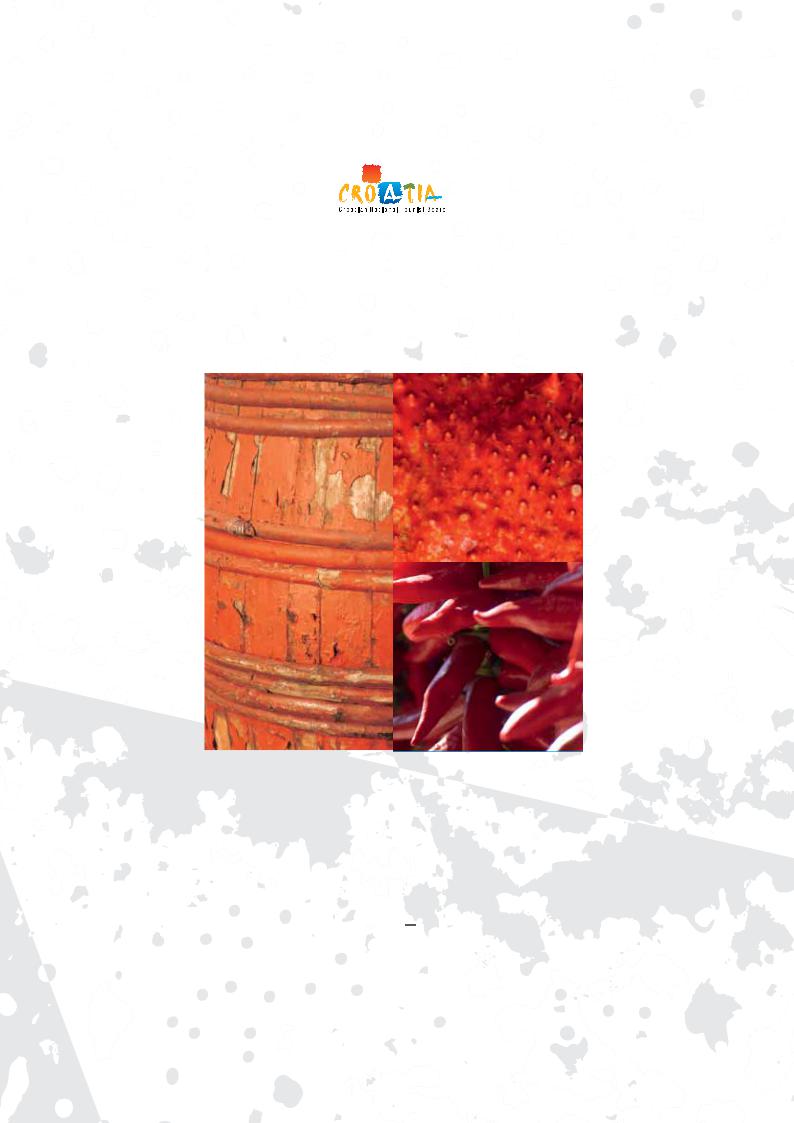
FREE
ceroatian g no
astronomy
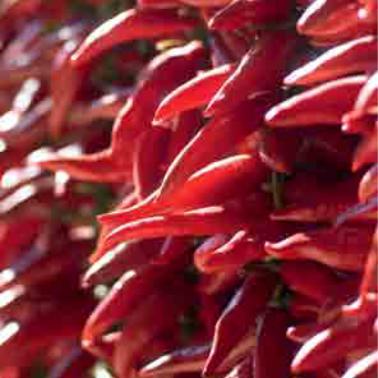
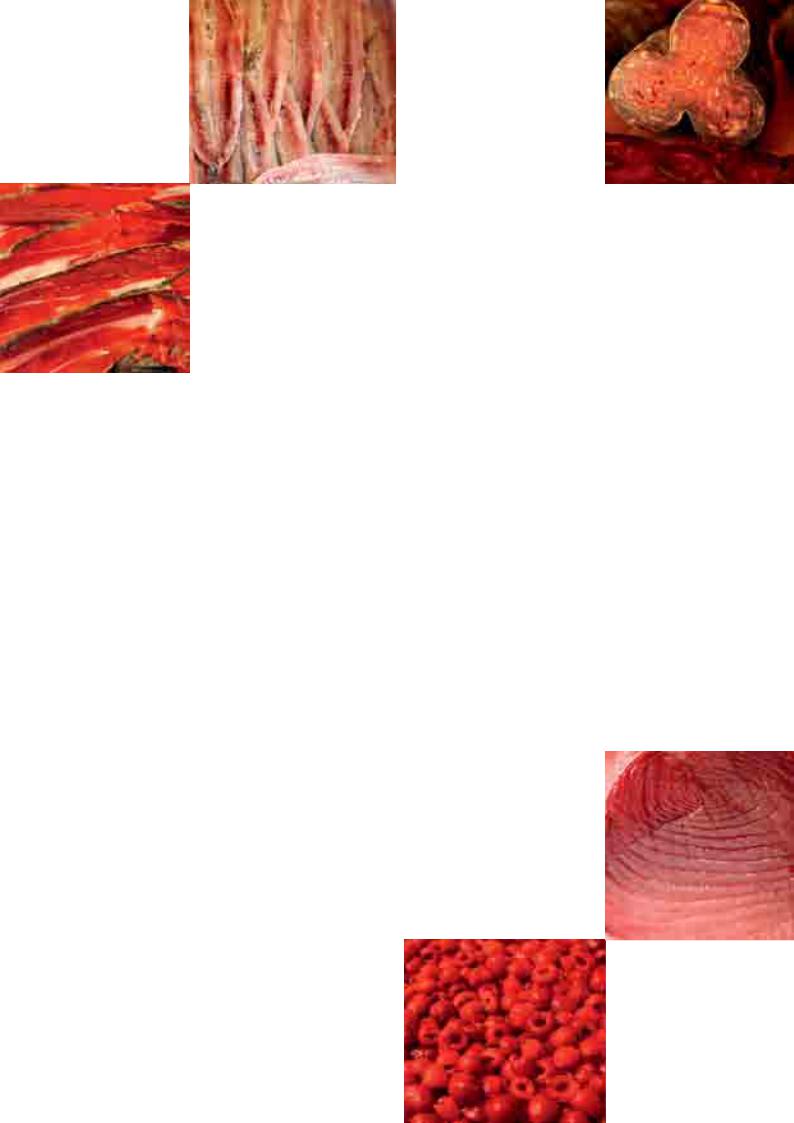
Introduction
Croatia, Gastronomic Princess of the Mediterranean and Europe |
|
4 |
|
The country of culinary diversity |
10 |
||
Why enjoy Croatia? |
|
12 |
|
Regions (Gastronomy, Health, About wine)
List of regions |
|
|
|
|
14 |
||
1_Istria |
16 |
||||||
2_Kvarner |
|
|
|
|
|||
|
|
|
24 |
||||
3_Lika_Karlovac |
|
|
32 |
||||
4_Dalmatia_Zadar |
38 |
||||||
5_Dalmatia_Šibenik |
|
|
|
|
|||
|
|
44 |
|||||
6_Dalmatia_Split |
50 |
||||||
7_Dalmatia_Dubrovnik |
|
56 |
|||||
8_Slavonia |
64 |
||||||
|
|
|
|||||
9_Central Croatia |
|
|
72 |
||||
10_Zagreb |
|
78 |
|||||
|
|
|
|
|
|
|
|
About wine and special subjects
About wine_Croatia – a small country for great wines |
86 |
|||
Olive oils_Benefits of olive oil |
|
|
88 |
|
Water_Water is life |
|
|
90 |
|
Ecological products |
|
92 |
||
Information
Basic information about Croatia |
94 |
||
Offices of the Croatian National Tourist Board |
|
|
|
95 |
|||
co n t e n t sAcknowledgements |
|
|
|
|
|
96 |
|
|
|
||
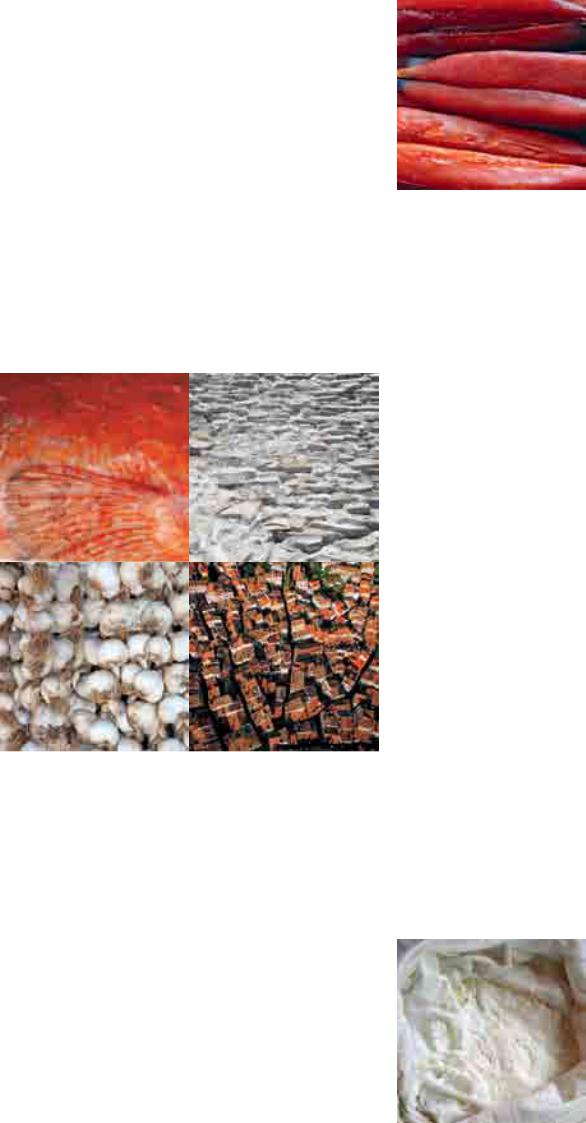
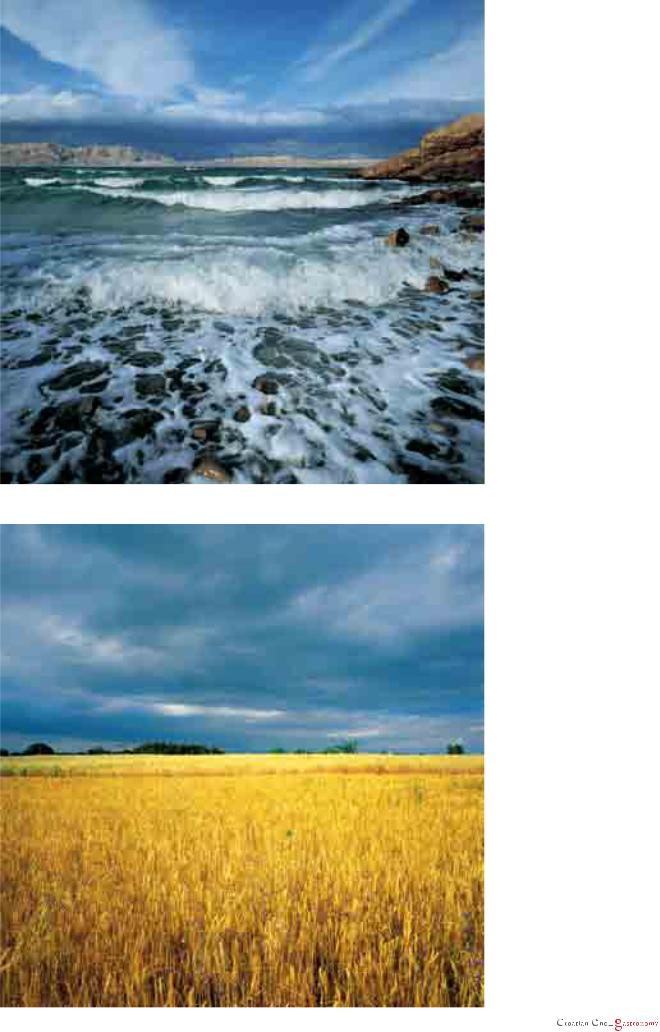
4

croatia, Gastronomic Princess
of the Mediterranean Veljko Barbieri and Europe
In the mid nineties, during the rescue excavations in Starogradsko Polje (old town field) on the island of Hvar, grape and olive seeds were found in one of the funeral urns. Researchers speculated that this was a common residue of agricultural crops from the 4th or 3rd century BC as it was thought that both cultures were connected to the arrival of the Greeks and the establishment of their colonies on the eastern coast. The seeds were sent to the Research Institute of the Old Culture in Phoenix, Arizona to be carbon tested and the results were a surprise to everyone. The seeds of the vines and the olive trees were in fact from the 9th or 8th century BC, that is from the time before the Greek colonisation. They date from the time of the Illyrian rule over the island and the Dalmatian coast. So the Illyrians, the warlike but disunited lords of our coast, inland and islands, also grew grapes and olives back in the ancient times and equally enjoyed wine and food, which they seasoned with olive oil. Later chronicles tell of great feasts and festivities at the Illyrian kings’ palaces, which of course continued over the Greek, Hellenistic period, in the already forgotten Symposion, banquet in Issa, Faros, Tragurion, Salons, Epetion, Epidaurus, and Korkyra (then the Greek island of Korčula). The feasts and festivities continued over a few centuries later when Rome finally gained control of all these areas, expanding its cosmopolitan culture, cultivation and wine production and bringing its tremendous cuisine based on olive oil. So, thanks to the findings in the small ceramic urns from Starogradsko fields, our knowledge about the history of the Mediterranean culture of crop farming has shifted to the early ancient world. Therefore the question of whether there is a genuine Croatian gastronomy and Croatian oenology, inseparably linked with Croatia, is pointless really, because they are both clearly identified as small, but separate parts, sometimes even more clearly recognisable than areas more famous for gastronomy and oenology. It is difficult to find in Europe, on such a small territory as today’s Croatia, so pronounced an intermingling of central and southern European, particularly Mediterranean, civilisations and culinary and oenological tradition. It would be more than presumptuous to compare Croatian cuisine and Croatian wine culture with the cuisine and wine traditions of larger nations, but the very diversity and traditions of Croatia identify it as a separate gastro entity.
If we tried to follow Croatia’s geographical and cultural traces by going on a journey through time and tastes, and if we started from the eastern Croatian borders, we would first meet the Croatian northeast and northwest, their true oenological and gastronomic accents associated with strong cultural influence, radiating from Western and Central Europe, from the Frankish Empire to the Austro-Hungarian Monarchy. Formed in such a gastro melting pot, in Eastern Slavonia, the most interesting dish is definitely shepherd’s stew. Deriving from Hungarian and Pan-
nonian influences, it condenses a soupy experience of goulash and stews with a special kaleidoscope of vegetables and spices, and of course wine, without which this unique dish can neither be prepared nor enjoyed. The dish can be spiced during cooking or later adjusted to taste when already seated at the table, with spices and wine such as Slavonian Traminac or Klikun, indigenous red and white noble Riesling from the cellars of the old Slavonian Ilok, Vukovar and Osijek, Đakovo and Vinkovci. If shepherd’s stew and Slavonian wines combine to create a trademark, then the best Slavonian culinary product is certainly kulen. This dried sausage with hot pepper, made from the best parts of pork meat, is unsurpassed in these parts of the European continent. The sausage is always accompanied by excellent wines.
Osijek, the capital of Slavonia which neighbours Vukovar, and in particular Đakovo and Vinkovci are also the capitals of stews, pork and poultry, especially duck. As they are hugged by the two great rivers, the Drava and the Danube, they also offer a menu of fresh water fish, giving them special culinary flair. Fish stews and Catfish perkelt (perkelti can be made with all sorts of meat, diced and stewed with peppers, onions and potatoes), like Hungarian ones but more dense and aromatic, are usually followed by fish broth, dried fish or fish sausages, while the fried carp, probably under the influence of the Ottoman Empire, is served with đuveč – oriental rice with vegetables. When Vinkovci’s horseradish soup arrives on the table first, it is usually followed by Baranja’s perkelt and the main course, Đakovo’s pork stuffed with smoked meat or ham, vegetables and tongue. All the dishes have a strong and desirable smell. Finally, a variety of thirty or so traditional Slavonian cakes usually served at weddings mark the end of every major culinary and wine festival. This short menu is accompanied of course by Eastern and Baranja wines, for many of which the taste was directly influenced by Hungary, from the great vineyards and cellars in Vilanju near Pečuh, or those immediately along the border in the Hungarian part of Baranja.
In the western part of Slavonia, this theme builds on the extensive dining experiences of immigrants and natives. So it is difficult to deny the roasted poultry filled with quince compote, accompanied by red Frankovka or Portugizac, their German, Austrian and Czech origins. Bean stew and sarma (pickled cabbage leaves stuffed with minced beef) are of Bosnian and Turkish origin, while the unique horse sausages and horse meat, which in Italy has disappeared from the menu, come from the Apennines. The highlands and hills are rich in small and big game, and there is an abundance of fish from rivers and ponds. The culinary simplicity and elegance distinguishes perch in sour cream as the finest dish of Western cuisine, followed by carp and ‘drunk’ carp baked in butter, fat and wine, poured over with golden wine from the vineyard. This is a true wine region, marked by the famous Roman Vallis Aurea or Golden Požega
introduction |
5 |
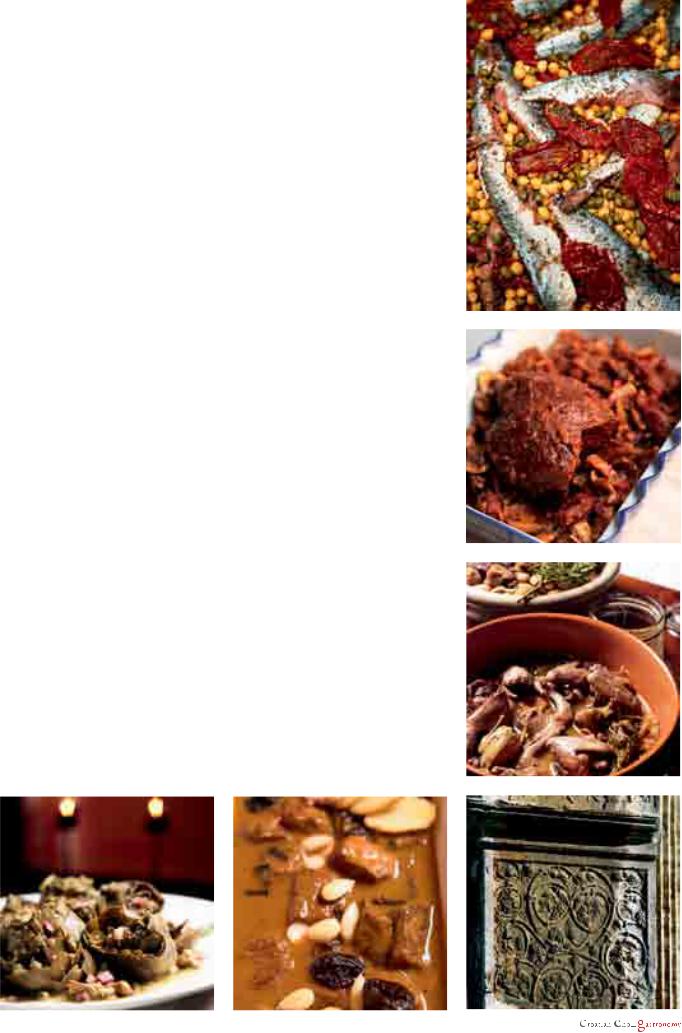
Valley, which extends all the way to the famous Kutjevo vineyards and cellars, and the hills that surround the very Požega highlands, Kamensko and the slopes of Papuk. It seems that everything around here evolved around and exists because of wine, while the wine and culinary flagship of Western cuisine is not conceivable without their top varieties, the already mentioned Traminac, Riesling, Chardonnay, Cabernet and Šipelj. Every meal is followed with a carefully selected wine, creating a special gastro-oenological circle.
Adjacent to Slavonia are Moslavina, Posavina and Banovina. Their original cellars ripen
Škrlet, Moslavac, Kraljevina, Frankovka and the whole range of afore-mentioned European white and red wines. The cellars have old cauldrons and the area is famous for roast meat platters from these, which are more ancient than the open-fire baked meat and sausages in fat, pepper and, of course, wine, adding more recently various vegetables and baked beans. Rabbit, poultry and game stew are boiled in pans over a fire. Here, geese and ducks can be seen roasting on a spit, especially during St. Martin, when the saint is said to come and baptise the young wine.
Podravina is proud of its festive tables, which offer marinated meat preserved in lard and diced bacon, which connects the province with Međimurje, Croatia’s land of fairy tales. In the mist rising over its rivers, forests, groves, fields and vineyards one can listen to a song from enchanted creatures from Međimurje’s mythology. The creatures sneak through the flavours of ducks and geese roasted in their own fat, meat from tiblica (a bowl characteristic of the Međimurje region used to prepare meat dishes) and pork in sour cream, wine and mushrooms, fish from the Drava and Mura rivers, especially the famous trout in red wine, which along with a dozen kinds of Međimurje pastry, swell on the tables looking like stuffed dwarfs. Everyone is seated or lying on tables, and next to them pushing through come the gourmets and drunkards of old from Čakovec, town of the Zrinski family and Varaždin, a Baroque centre of northern Croatia, an urban centre and the former Croatian capital. They are proud members of one of the most famous baroque
butchers’ guilds of Europe, the body that has ruled their city for two centuries.
For them were prepared old Varaždin rajžleci (an old dish made of veal stomach), pâtés made from livers and poultry, and veal shank in wine and cream, as well as stuffed goose and duck breast in gingerbread dough. In one whole day of feasting, according to books neatly written by Varaždin’s butcher’s guild, back in 1693, these gourmet masters, about thirty of them, consumed no less than one whole calf, four pigs, a dozen pounds of cooked beef, a few chickens, pigeons, turkeys, geese and ducks, along with a brace of rabbits, wild birds, lots of sausage, exactly 22 hens, a few ox tongues on skewers and a bunch of snails. If you leave out the desserts, it is noted that on this ancient day, a few hundred litres of wine was drunk, and if the accounts are to be trusted, exactly 360 litres, but that is, to tell the truth, an unbelievable amount.
However, those are extremely delicious and nicely decorated menus depicting palaces and bell-towers of the historical Croatian capital, but also of Međimurje’s capital. The wine from nearby Međimurje Štrigova is poured into glasses, the wines gurgle and clinking of the goblets full of indigenous Međimurje Pušipel and golden Muškat blend with aromas and flavours of excellent and original dishes listed in the famous 17th century cookbook from the palace of the Zrinski family in Čakovec, in which for each recipe, the original baroque culinary experience is explained. The dishes were cooked in the kitchens of this powerful family and relied equally on European influences, especially those from Italy, Hungary and Austria, Germany, Portugal and even Spain.
Zagorje, Zagreb’s entrance hall, scattered villages spread over hills is home to baked and fried chicken, turkey with dumplings, strong flavoured soups made with poultry and mushrooms, venison in wine sauces, cooked smoked meat served with a stew of beans and pumpkin, sauerkraut and nettle soup, which accompanied the famous garlic sausage and black pudding, sausage seasoned with garlic and blood. It is also an ancient oenological area whose exquisite varieties such as Riesling, Graševina (a sort
6
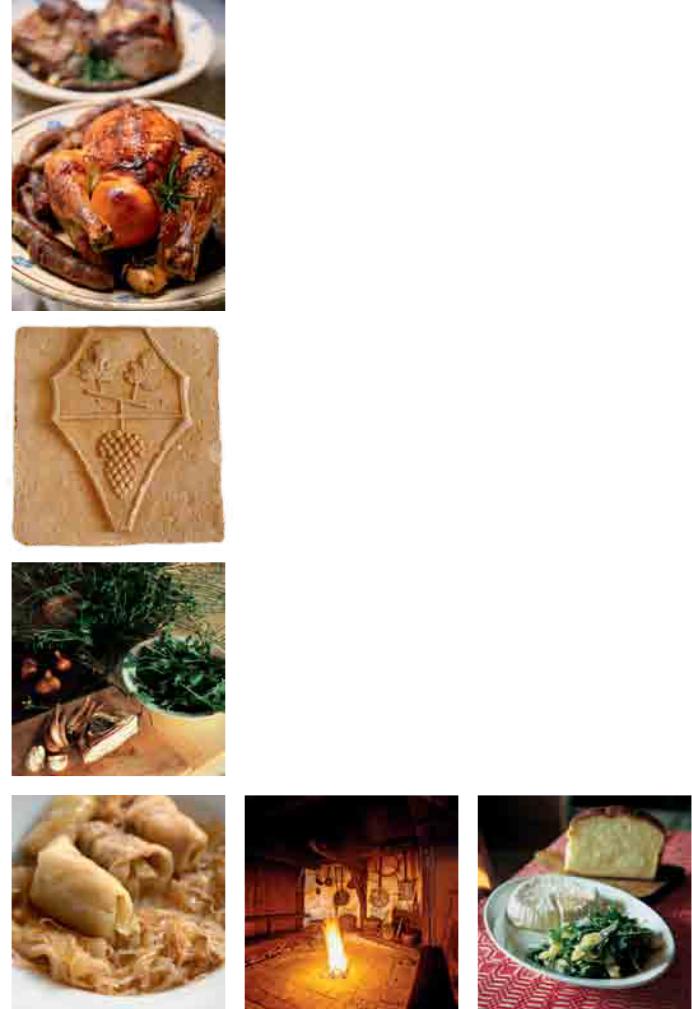
of Riesling), Traminac and Šipon inspire with a fresh dry taste. Zagorje’s pork tenderloin with dried plums marinated in imported Chardonnay – a recipe recorded in 16th century gourmet menus – is a bridge to the menus of the Croatian capital of Zagreb.
Old Agram (an old historic restaurant in the green part of Zagreb serving local food and good wine) is a respected cultural and urban representative of Central Europe. From its kitchens and wine cellars the tradition emerges at every step. The palate and taste of Zagreb reflect revised Austro-Hungarian flair, but they also reflect centuries long cultural and oenological experience from Zagorje and closer Turopolje which normally protects the province from the centre, cities like Zagreb from its former metropolises such as Vienna. Of course it is not surprising to anyone that Zagreb’s tables are full of minced or fried and breaded meat steaks, preceded by the famous Zagreb’s ajngemahtes, soup with poultry or veal with root vegetables and peas, and finally Provincial Cordon Bleu, veal, pretentiously stuffed with ham and cheese. It is as if Zagreb wants to emphasize the superiority of its provincialism, as it is really more interesting than its culinary Viennese model. A special place is dedicated to agramerski ričet made of beans and barley with smoked meat and veal soup, refined foods and pâtés made of poultry and game, and with them good old tenderloin in wine, and at the feast’s endthe original Zagreb cherry strudel, which was adopted by Viennese cuisine too.
Roasted young boar out of the oven, also bathed in wine, and cooked ox tails with homemade Samobor mustard, as well as famous organic chicken dishes, lead us to another baroque Croatian capital, the old town of knights – Samobor. Known for its excellent meat menus in which along with the dishes already mentioned there is a proud smell of grilled pork and grilled pork chops, then old Samobor catfish soup with cream and white wine, stuffed breast of veal and shank from the oven, the strudels and pastry, especially cream cake (kremšnita), served with dessert wine, Samobor Bermet and wines from nearby Žumberak and its vineyards.
From here, from nearby Lika and Gorski Kotar region, a whole food and wine world emanates and it seemed that it lived as an ancient legend hidden in the ancient forests, the purest Croatian riverbeds and old fortresses and cities. The entire area is dominated by the city of Karlovac, a military center of Krajina streching from Ozalj to Rijeka and the Croatian Primorje coast, whose kitchen breathes originality, not only from AustroHungarian influences but also the influences of those in Samobor that were left behind by Napoleon’s soldiers with their town as well as rural menus from simple egg and flour soups, thick soup with mushrooms and meat soup, Dugoreška’s dish, roasted and cooked meat, shank, breast and ham, traditional rabbit in sauce with cloves. They are followed by dishes from a rich fish menu, because this is an area bordered by the clearest Croatian rivers Kupa, Retina, Korana and Dobra, mainly inhabited with pike and perch, catfish and carp. There are also porridge and vegetable stews or beans, fungi, mainly highly prized mushrooms such as vrganj and lisičke, homemade noodles in imaginative sauces, pies, bazlamača (a simple cake made of corn flour, eggs, cottage cheese and cream, typical of Zagorje and Međimurje), kuglof and cakes.
Across the boundaries of Gorski Kotar and the Ogulin part of Lika, there with Ogulin at its centre famous for its array of homemade breads, smisovnica (a type of multigrain bread), bread with onions and dry meat specialties from deer and bear, various kinds of meat with Ogulin’s renowned cabbage and vegetables and game dishes from nearby Josipdol: deer, venison, boar, rabbit, pheasant, quail and snipe, Lika’s roasted lamb and baked potatoes under the bell, as well as an excellent selection of cheeses such as indigenous Tounj’s cheese (smoked cheese from Tounj, Lika) and škripavac (a type of haloumi cheese) and mature cheese spreads, served with a cornflour bread or bread baked from the flour of seven different grains ...
However, this is just a list of various foods from the area and they are followed by an army of cakes that wake up the taste buds, while this gastronomic power is accompanied by the honour guard of wines from Vivod-
introduction |
7 |
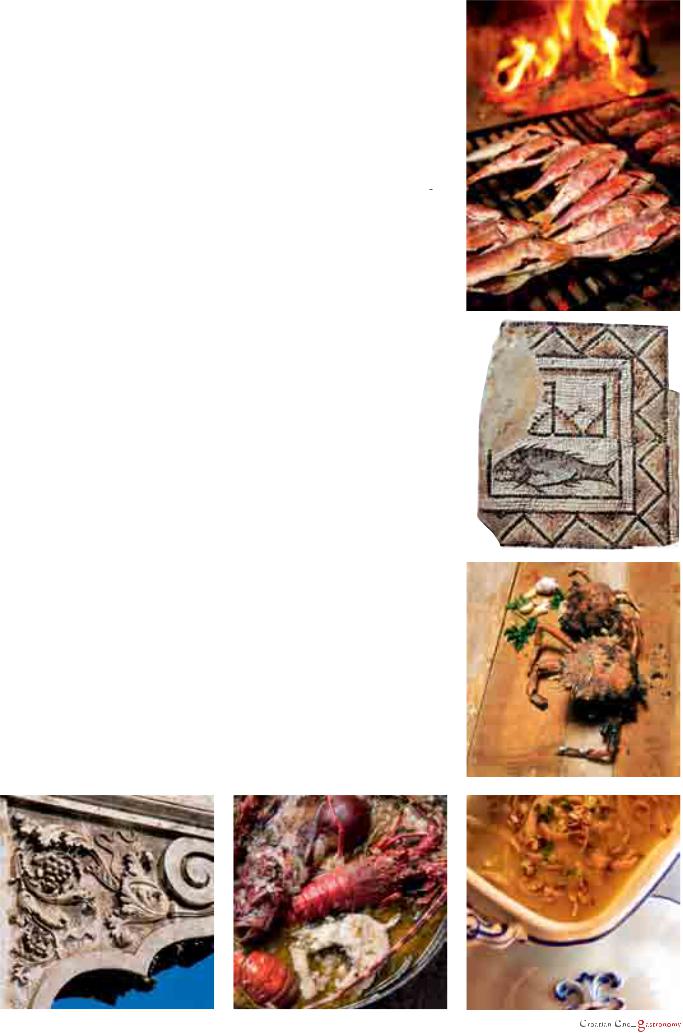
insko, Ozalj, Ogulin, Duga Resa, Draganići with Raina’s Riesling, Muscatel, Traminer, Chardonnay, Franconia, and the especially celebrated ice harvested wines, an oenological tradition.
With those highlighted ancient highland dishes and wines nowhere else in Croatia does one get the feeling that time has stood still than in the regions of Istria and Dalmatia. These two regions stand out as special features of Croatia, the authentic life and gastronomic ambience which have admittedly drawn their inspiration from their exemplars especially Venice, but they knew how to build on them with the strength of their own culinary knowledge and experience. We can begin with Istrian minestrone and jotas, thick soups made of dried/smoked meat and beans, Istrian žgvaceti with venison or lamb (a pasta dish with meat stew), various sauces from famous Istrian truffles and asparagus, which are poured over Istrian fuži (homemade pasta) and pljukanci (homemade tortellini), very similar to old medieval macaroni, or to season fine risottos.
Pazin’s famous roasted turkeys with sour apples are baked in the oven, and along with pears and fruit, sausages and smoked pork loin on gradele (a type of grill used along the Croatian coast for grilling meat, mainly fish), along with fish, clams and big crabs in risottos with truffles, sophisticated lešade (a traditional light meal consisting of cooked fish served with boiled vegetables and fish soup) and brujeti (fish cooked in wine) in which the taste of wine and olive oil permeate as gifts of the Istrian soil, with mixed fish and crabs from Istrian waters. These products of sea and land, along the banks of their coastal towns or at the foot of their hills and mountains over which guard famous Istrian castles, are served in various šugovi (juices or sauces made of tomato or seafood) dominated by the famous Greek Malvasia imported by the Venetians, but which in Istria has surpassed its role models. In addition to imported Merlot, there is also the indigenous red Istrian Teran with a bitter and strong taste and fragrant color from which the famous Istrian Teran soup, seasoned with cloves and served with toasted bread, is made.
All this along with the inevitable asparagus in Spring, with Autumn chestnuts and truffles, particularly the white ones, strong-smelling and with a distinct taste, like the Istrian cuisine itself, which has managed to turn all those imported techniques and know-how into its own culinary expression. Istrian culinary expression is not only felt in Liburnia, an area at the foot of Učka, in its dishes flavoured with Spring and Summer asparagus and cherries, with famous Autumn chestnuts from Lovran, but also on the islands of Cres, Lošinj and Rab, whose soil also contains the seeds of ancient varieties, notably the original žlahtina (an authentic Croatian white wine). This, in parallel embraces the individual civilization, oenological and gastronomic traditions which are based on lamb and goat, while the deep sea whispers tales of big crabs, clams and fish.
But, if on the journey through time and tastes, we try to come up with the menu that consists of a complex series of passages of time, then it is best to look for it in Dalmatia. In Dalmatia, one can still feel the dawn of civilization from which the Mediterranean cuisine originates. Its cuisine is so gentle and classically basic, refined, but sometimes old fashioned in the modern culinary sense, as a mirror of the old Mediterranean. Fish, shellfish and crabs of all kinds, prepared in various ways: baked, boiled in marinades
– na buzare (cooked in wine in seashells)- which all derive from Dalmatia or cooked in the famous Dalmatian brujeti, seemingly similar to the Venetian broéti and Provencal bouillabaisses. Followed by vegetables dishes, often mixed beans like French cassoulet and preparations made from cabbage, lamb and goat meat, giblets or ancient pirjanci ( a type of meat stew) such as famous pašticada, in its composition of ancient and Byzantine origin, but with a strong Dalmatian emphasis.
Culinary courtesy is included that province in the Mediterranean culinary kaleidoscope made up of ancient sea urchins and raw fish, roast from under metal or ceramic bells, unique bread cakes filled with salted fish from the island of Vis in which it is easy to recognize its ancient Greek origin. Here we dis-
8
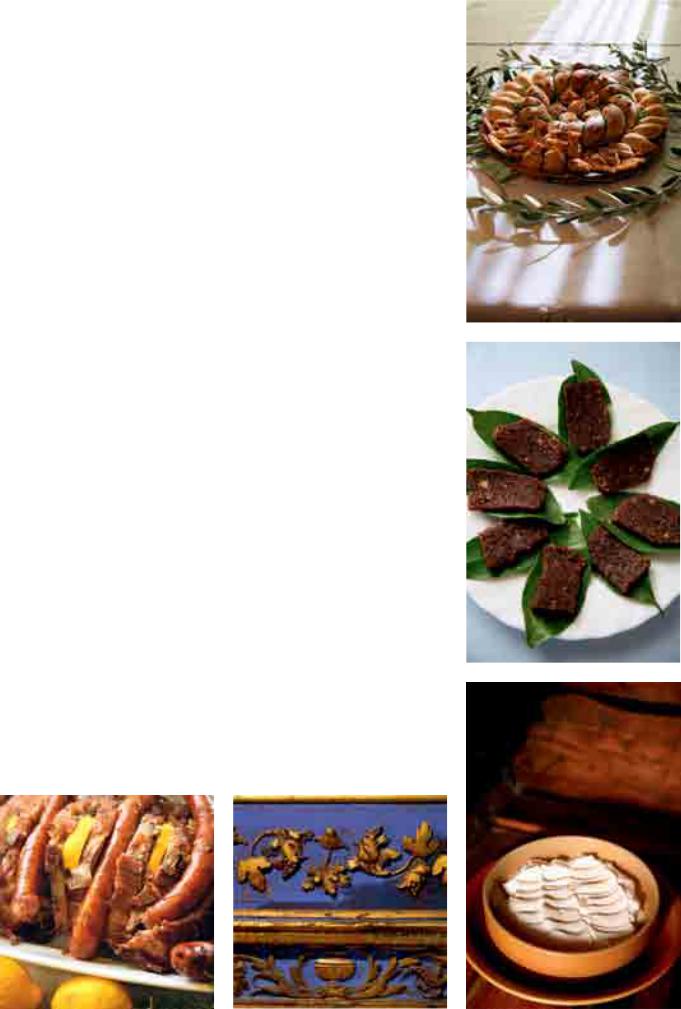
cover the ability of inheritance – in Neolithic lamb tripe, classical tripe and Brač vitalac (a tripe type of food made on the island of Brač), goat or lamb meat and giblets on the spit, and good old tinguli with venison and poultry, also from Apennine roots, various seafood casseroles like Hvar’s broth, which even in its own name reveals links with Greece, continuing the long tradition of Hellenic and Byzantine presence. Since olden times the fish in Dalmatia is roasted on a grill or a spit, like sardines on the islands, while octopus tentacles, cuttlefish and squid are filled with their own flesh, sometimes pieces of shrimps or pršut (prosciutto) – the best smoked ham of the Mediterranean. Dried fish and salted fish, was exported for centuries, but also prepared for festive occasions in dishes similar to today’s codfish bakalar (a cod fish). But, Venice has also enjoyed the Dalmatian kaštradina, dried mutton or goat meat with Dalmatian cabbage. Castrati dalmati (Dalmatian kaštradina) and Cavoli dalmati (Dalmatian cabbage) were equally valued as were tongues cooked with cloves and coriander, and above all, the pots of beans and cabbage already mentioned, which along with many other native foods have outgrown their culinary horizon.
According to historians, the emperor Diocletian himself before his death cultivated cabbage in the vicinity of the palace in Split, renaissance gastronomes like Platin and Scappi praised Dalmatian game in wine, olive oil, lemon and rosemary. In the deltas of Dalmatian rivers the brujeti of eels and frogs are cooked, they are followed by crayfish in mint and tomatoes salsa. In the Spring, off the Dalmatian tables glide snails in hot pepper sauce, asparagus and artichokes prepared in dozens of ways smelling nicely in pots and pans. Dalmatia is a land of mountain and island lamb and goat, veal, pork and smoked meat, of which the traditional roasting and lešade with salsa, capers and coarse salt are prepared.
During harvesting of the famous native wine varieties such as Plavac Mali – decisive and dominant wine of Croatia, as well indigenous as Kaštela’s Crljenka and Primošten’s Babić, Šibenik’s Debit, islands’ Pošip, Parča, Bogdanuša, Vugava or Maraština, polpete
(meatballs) of mutton are baked, while in the inland the Sinj’s arambašići, a domestic version of the Turkish-Bosnian sarma compete with its Ottoman model. Then the original Dalmatian inland varieties such as white Zlatarica and honey or red Trnka are served on a table. On the islands the famous cheeses, such as Pag’s and Silba’s and young sheep’s and goat’s cheeses, accompany almond and carob cakes, ravioli, fritters and cheese pies, Carnival cakes which arrived in the area with a carnival from Venice and were embodied within the strong local tradition.
In the cuisine of the Dubrovnik Republic the biggest impression on travellers left a green pasta of kale, cabbage and kaštradina, pasta Ragusei dei Verdi, as they were called by the Apennine’s gastronomes, then clams and oysters from Mali Ston Bay, which also celebrated this small southeastern state and its cuisine. These are only small fragments of the great courses illustrated by rožate and renaissance pepper biscuits with honey and ammonia or, in the culinary world, a famous cake Makarana made of almonds, eggs and the famous Maraschino liqueur, which inspired even Giacomo Casanova in his amorous adventures, or at his writing desk.
As a final fragment of one never completed menu, created in a split between epochs, which, from dish to dish, from wine to wine, married the gastronomy of Croatia and Croatian oenology.
Sometimes the main idea about the Croatian cultural, oenological and gastronomic regions may have been misunderstood, especially after close examination of Balkan culinary habits. However, the gastronomic variety of dishes and menus, native and imported wine varieties, similarities and differences, influences and originality, slowly started to merge in the same way that spices and ingredients match in good food, food with wine, and the region and its history combine in the original flavors and odors. Such a menu and wine list which reflect our common heritage, Croatian cuisine and Croatian oenology offer a small but distinct and valuable opportunity for study and discovery of the Mediterranean and Europe.
introduction |
9 |
